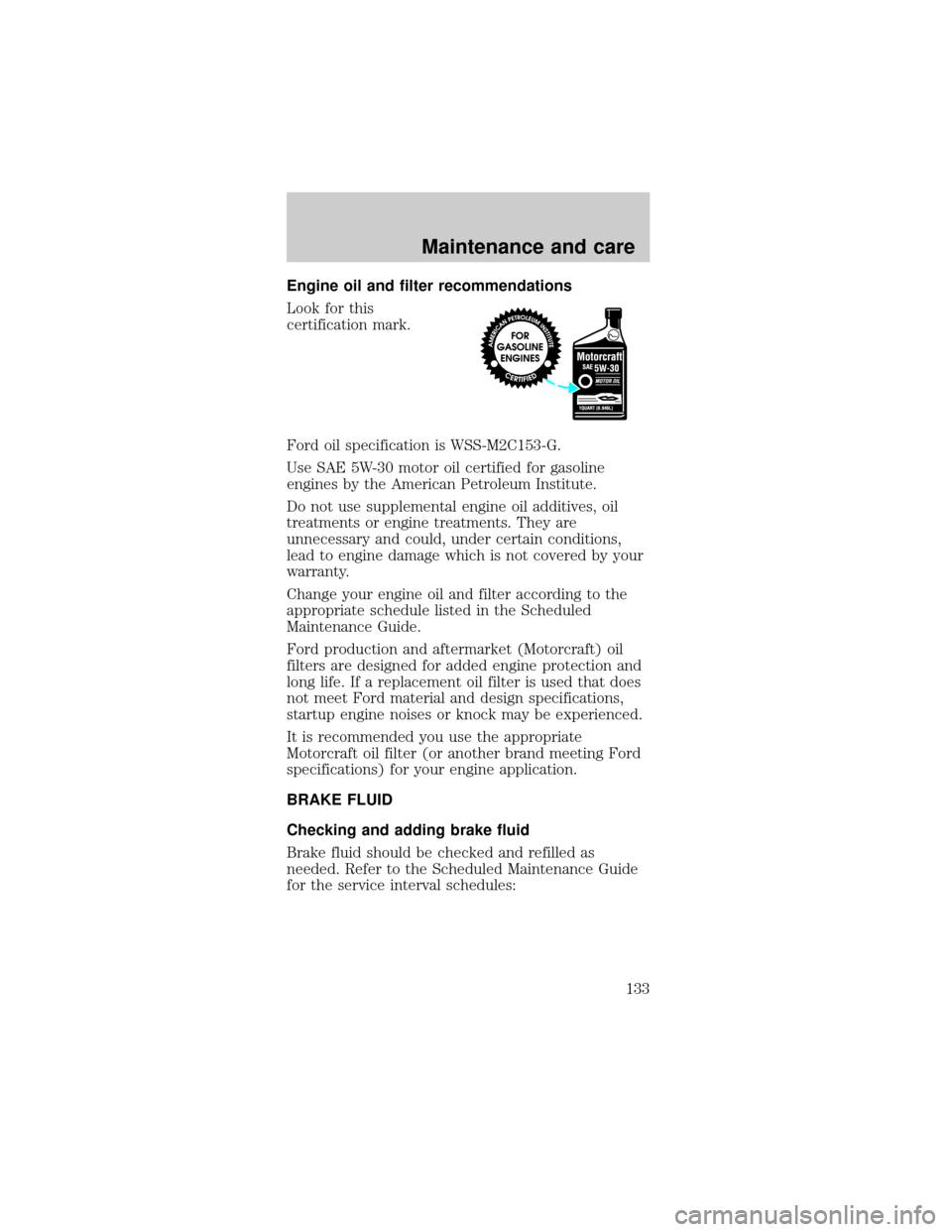Page 132 of 192
²If the oil level is
below the MIN mark,
add enough oil to
raise the level within
the MINÐMAX
range.
²Oil levels above the MAX mark may cause engine
damage. Some oil must be removed from the
engine by a service technician.
7. Put the indicator back in and ensure it is fully
seated.
Adding engine oil
1. Check the engine oil. For instructions, refer to
Checking the engine oilin this chapter.
2. If the engine oil level is not within the normal
range, add only certified engine oil of the
recommended viscosity. Remove the engine oil filler
cap and use a funnel to pour the engine oil into the
opening.
3. Recheck the engine oil level. Make sure the oil
level is not above the F in FULL mark on the
dipstick.
Maintenance and care
132
Page 133 of 192

Engine oil and filter recommendations
Look for this
certification mark.
Ford oil specification is WSS-M2C153-G.
Use SAE 5W-30 motor oil certified for gasoline
engines by the American Petroleum Institute.
Do not use supplemental engine oil additives, oil
treatments or engine treatments. They are
unnecessary and could, under certain conditions,
lead to engine damage which is not covered by your
warranty.
Change your engine oil and filter according to the
appropriate schedule listed in the Scheduled
Maintenance Guide.
Ford production and aftermarket (Motorcraft) oil
filters are designed for added engine protection and
long life. If a replacement oil filter is used that does
not meet Ford material and design specifications,
startup engine noises or knock may be experienced.
It is recommended you use the appropriate
Motorcraft oil filter (or another brand meeting Ford
specifications) for your engine application.
BRAKE FLUID
Checking and adding brake fluid
Brake fluid should be checked and refilled as
needed. Refer to the Scheduled Maintenance Guide
for the service interval schedules:
Maintenance and care
133
Page 162 of 192

²Combine errands and minimize stop-and-go
driving.
Maintenance
²Keep tires properly inflated and use only
recommended size.
²Operating a vehicle with the wheels out of
alignment will reduce fuel economy.
²Use recommended engine oil. Refer toLubricant
Specifications.
²Perform all regularly scheduled maintenance
items. Follow the recommended maintenance
schedule and owner maintenance checks found in
your vehicle Scheduled Maintenance Guide.
Conditions
²Heavily loading a vehicle or towing a trailer may
reduce fuel economy at any speed.
²Carrying unnecessary weight may reduce fuel
economy (approximately 2 km/h [1 mpg] is lost
for every 180 kg [400 lb] of weight carried).
²Adding certain accessories to your vehicle (for
example bug deflectors, rollover/light bars,
running boards, ski/luggage racks) may reduce
fuel economy.
²Use of fuel blended with alcohol may lower fuel
economy.
²Fuel economy may decrease with lower
temperatures during the first 12±16 km
(8±10 miles) of driving.
²Flat terrain driving improves fuel economy over
hilly roads.
²Transmissions give their best fuel economy when
operated in the top cruise gear and with steady
pressure on the gas pedal.
²Close windows for high speed driving.
Maintenance and care
162
Page 186 of 192

Air bag supplemental
restraint system ........ 71
and child
safety seats ............. 73
description .............. 72
disposal .................... 76
indicator light ......... 75
passenger air bag ... 74
Automatic transmission
driving an automatic
overdrive .. 94,95,96,97
Axle
refill capacities ...... 178
Battery
voltage gauge .......... 15
Brakes ................... 88,90
anti-lock .............. 88,89
anti-lock brake
system (ABS)
warning light ........... 89
fluid, checking
and adding ............ 133
shift interlock .......... 93
Break-in period ........ 2,3
Child safety seats
attaching with
tether straps ........... 82
in rear seat .............. 80
tether anchorage
hardware ................. 82
Cleaning
your vehicle ............. 171
engine
compartment ......... 173
exterior ........... 173,176
exterior lamps ....... 174
interior ................... 175
plastic parts .......... 174
washing .................. 172
waxing ................... 172
wheels .................... 173
windows ................ 176wiper blades .......... 174
Clutch
fluid ........................ 135
operation
while driving ........... 98
recommended shift
speeds ...................... 99
Console ...................... 52
Controls
power seat ............... 64
Convertible ................ 53
cleaning ................. 176
installation
of the boot .............. 54
lowering the
convertible top ........ 53
raising the
convertible top ........ 55
Coolant ............. 139,140
checking
and adding ............ 138
refill capacities ...... 140
Defrost
rear window ............ 17
Emission
control system ......... 163
Engine
coolant ................... 137
idle speed control . 146
service points . 129,130
starting after a
collision ................. 108
Engine block heater . 86
Engine oil
checking
and adding ............ 132
dipstick .................. 130
specifications . 130,133
Exhaust fumes .......... 87
Floor mats ................. 51
Index
186